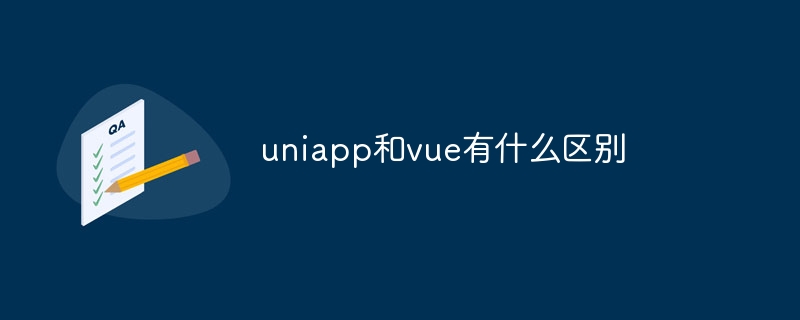What is the difference between uniapp and vue
UniApp and Vue are different web application frameworks. UniApp supports cross-platform development, while Vue is mainly used for web development. UniApp uses JavaScript and Vue, and Vue uses JavaScript and Typescript. UniApp integrates Weex as the UI rendering engine, and Vue uses Vue.js as the UI framework. UniApp has an ecosystem for cross-platform development, while Vue has an extensive ecosystem focused on web development.

The difference between UniApp and Vue
UniApp and Vue are two different web application development frameworks. There are some key differences in functionality and use cases:
1. Cross-platform compatibility
- UniApp: a cross-platform framework that supports iOS, Android Build applications on multiple platforms such as and the Web.
- Vue: A framework focused on web development, primarily used for building single-page web applications.
2. Development language
- UniApp: Use JavaScript and Vue (optional).
- Vue: Use JavaScript and Typescript (optional).
3. UI framework
- UniApp: Integrates Weex as the UI rendering engine to provide unified cross-platform UI components.
- Vue: Uses Vue.js as its UI framework to provide component-based UI construction.
4. Ecosystem
- UniApp: Has an ecosystem of plugins and libraries specifically designed for cross-platform development.
- Vue: Has an extensive ecosystem that includes a variety of third-party libraries and tools, with a focus on web development.
5. Performance
- UniApp: Due to its cross-platform nature, performance may be lower than native apps.
- Vue: Due to its focus on web development, performance is generally higher than UniApp.
6. Development experience
- UniApp: Provides a unified development environment that supports multi-platform preview and debugging.
- Vue: Rely on third-party tools (such as Vue CLI) to set up the development environment.
7. Use cases
- UniApp: Suitable for situations where applications need to be developed and deployed quickly across multiple platforms.
- Vue: Suitable for pure web application development or web interfaces that require high performance.
The above is the detailed content of What is the difference between uniapp and vue. For more information, please follow other related articles on the PHP Chinese website!

Hot AI Tools

Undresser.AI Undress
AI-powered app for creating realistic nude photos

AI Clothes Remover
Online AI tool for removing clothes from photos.

Undress AI Tool
Undress images for free

Clothoff.io
AI clothes remover

AI Hentai Generator
Generate AI Hentai for free.

Hot Article

Hot Tools

Notepad++7.3.1
Easy-to-use and free code editor

SublimeText3 Chinese version
Chinese version, very easy to use

Zend Studio 13.0.1
Powerful PHP integrated development environment

Dreamweaver CS6
Visual web development tools

SublimeText3 Mac version
God-level code editing software (SublimeText3)

Hot Topics
 1371
1371
 52
52
 How do I handle local storage in uni-app?
Mar 11, 2025 pm 07:12 PM
How do I handle local storage in uni-app?
Mar 11, 2025 pm 07:12 PM
This article details uni-app's local storage APIs (uni.setStorageSync(), uni.getStorageSync(), and their async counterparts), emphasizing best practices like using descriptive keys, limiting data size, and handling JSON parsing. It stresses that lo
 How do I make API requests and handle data in uni-app?
Mar 11, 2025 pm 07:09 PM
How do I make API requests and handle data in uni-app?
Mar 11, 2025 pm 07:09 PM
This article details making and securing API requests within uni-app using uni.request or Axios. It covers handling JSON responses, best security practices (HTTPS, authentication, input validation), troubleshooting failures (network issues, CORS, s
 How do I use uni-app's geolocation APIs?
Mar 11, 2025 pm 07:14 PM
How do I use uni-app's geolocation APIs?
Mar 11, 2025 pm 07:14 PM
This article details uni-app's geolocation APIs, focusing on uni.getLocation(). It addresses common pitfalls like incorrect coordinate systems (gcj02 vs. wgs84) and permission issues. Improving location accuracy via averaging readings and handling
 How do I use uni-app's social sharing APIs?
Mar 13, 2025 pm 06:30 PM
How do I use uni-app's social sharing APIs?
Mar 13, 2025 pm 06:30 PM
The article details how to integrate social sharing into uni-app projects using uni.share API, covering setup, configuration, and testing across platforms like WeChat and Weibo.
 How do I manage state in uni-app using Vuex or Pinia?
Mar 11, 2025 pm 07:08 PM
How do I manage state in uni-app using Vuex or Pinia?
Mar 11, 2025 pm 07:08 PM
This article compares Vuex and Pinia for state management in uni-app. It details their features, implementation, and best practices, highlighting Pinia's simplicity versus Vuex's structure. The choice depends on project complexity, with Pinia suita
 How do I use uni-app's easycom feature for automatic component registration?
Mar 11, 2025 pm 07:11 PM
How do I use uni-app's easycom feature for automatic component registration?
Mar 11, 2025 pm 07:11 PM
This article explains uni-app's easycom feature, automating component registration. It details configuration, including autoscan and custom component mapping, highlighting benefits like reduced boilerplate, improved speed, and enhanced readability.
 How do I use preprocessors (Sass, Less) with uni-app?
Mar 18, 2025 pm 12:20 PM
How do I use preprocessors (Sass, Less) with uni-app?
Mar 18, 2025 pm 12:20 PM
Article discusses using Sass and Less preprocessors in uni-app, detailing setup, benefits, and dual usage. Main focus is on configuration and advantages.[159 characters]
 How do I use uni-app's uni.request API for making HTTP requests?
Mar 11, 2025 pm 07:13 PM
How do I use uni-app's uni.request API for making HTTP requests?
Mar 11, 2025 pm 07:13 PM
This article details uni.request API in uni-app for making HTTP requests. It covers basic usage, advanced options (methods, headers, data types), robust error handling techniques (fail callbacks, status code checks), and integration with authenticat




